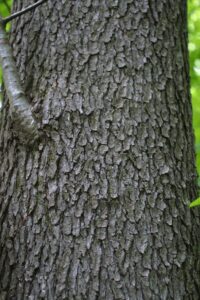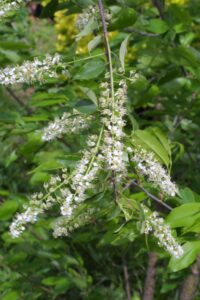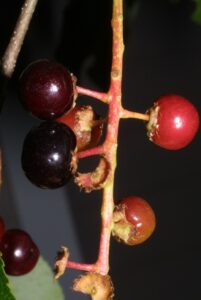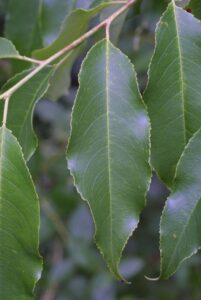Botanical Name:
Prunus serotina
Family Name:
Rosaceae / Rose
Description:
This moderately long-lived tree produces clusters of showy white flowers in the spring and small dark fruits in the late summer. Despite being called black cherry, this tree is not closely related to the commonly cultivated cherry species.
Size:
50-80’
Habitat and Range:
The black cherry grows best in forests with deep soils, however this tree is often seen in surprising places because of birds spreading their seeds. This cherry is native to eastern North America but has populations in Arizona, New Mexico, and in the mountains of Mexico and Guatemala. It is an invasive species in Europe.
Attributes:
While most of the large trees have been harvested for their valuable wood, this large cherry boasts simple elliptical leaves that are dark green in the summer and yellow to red in the fall. In May drooping clusters of small white flowers festoon the tree. These flowers will give rise to reddish-black berries in the late summer. The mature bark of the tree is dark and scaly, often flipping on the edges.
Wildlife Value:
The flowers of the black cherry offer nectar and pollen to entice a variety of bee and fly species. Many insects and caterpillars, including that of the Eastern Tiger Swallowtail, enjoy the leaves of the black cherry. Nectar is also produced by the glands on the leaf of the black cherry which lures ants to that help protect the tree from the effects of too many caterpillars. Birds, squirrels, deer, raccoon, black bears, ruffed grouse, opossum, and turkey feast on the fruit of the black cherry. While the bark, leaves and twigs of this tree are poisonous to livestock, deer can eat them without harm.
Did you Know?
• While the berries are edible, they are commonly used for jellies or wines as they are fairly tart directly from the tree. The leaves of this tree and the cherry pits contain cyanide and should not be eaten.
• The national champion black cherry is located in Great Smoky National Park and is 134 feet tall.
Benefits to Our Community (based on carbon dioxide sequestered, storm water runoff avoided, and air pollution removed each year):
Over the next 15 years, this tree will give back $45 worth of benefits to our community.




